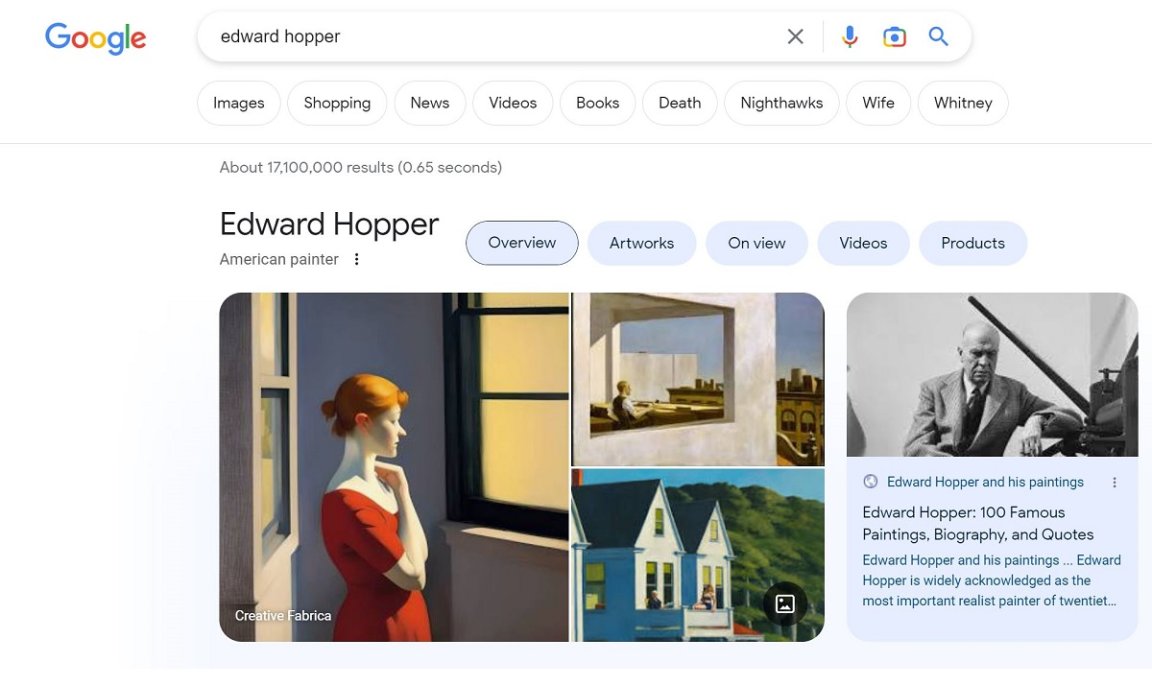
AI is already rewriting art history.
When you Googled the famed realist artist Edward Hopper this week, the first featured image that appeared was convincing enough. A lone woman, painted in the artist’s signature soft, muted style, stared out a window, sporting a red dress and hair tucked into a bun. Hopper created a number of similar paintings throughout his career; casual viewers, and even some not-so-casual ones, probably wouldn’t think twice.
But they’d be deeply misled. Though it was certainly created in the style of the American great, the painting in question isn’t a real Hopper. It’s an AI-generated knockoff of the real artist’s work — and in what feels like an unsettling turn for the internet’s fraught information ecosystem, the fake somehow made it to the top of Google’s search results.
“If you don’t think visual AI is a problem,” tweeted UK-based illustrator Penny Neville-Lee, who first caught the AI fake, “this is what comes up when you Google Edward Hopper.”
The fact that the image was AI-generated became clear pretty quickly. For one thing, the woman’s forearm and hand — a detail with which AI has long struggled — look downright bizarre.
And the website that the image is featured on — a digital art-sharing platform called Creative Fabrica which, in what appears to be a more recent addition to the site, features an AI-integrated platform that allows users to generate art — even provides which prompt was used to create the image: “a woman looking outside the window by Edward Hopper.”
From there, the page for the platform’s text-to-image integration tells you all you need to know.
“Now you can create any image you can imagine and use it for your crafting projects,” reads the website. “These creations are generated using Artificial Intelligence and are all one-of-a-kind.”
All to say, you don’t need to be an AI expert or internet sleuth extraordinaire to confirm that this painting isn’t the real deal. But while that may have been simple enough for a human to decipher, the reality — and the concern — still stands that Google’s algorithms weren’t able to bridge the same divide, not just allowing the image to show up on the second or third page of search results but featuring the AI-generated art in the search engine’s algorithm-determined overview of the artist’s work. In other words, one algorithm’s fake painting fooled Google’s algorithm. The snake has officially started to eat its tail.
Sure, to human eyes, there are enough red flags to keep anyone from soundly passing this work off as the real deal. But our digital worlds are facilitated much more by algorithms — Google, Bing, social media recommendation engines, and increasingly AI — than they are people.
And to that end, in terms of both scale and quality, it’s probably fair to say that synthetic content has only just scratched the surface.
As more AI content, whether image or text-based, begins to flood the internet, it’s very unlikely that all AI generations will be as obviously machine-made as this one. If Google and other search engines are unable to filter through AI content more effectively, convincing AI fabrications have a means of slipping through the historical — distorting and confusing established history, yes, but perhaps destabilizing and even rewriting history education as well.
“When one Googles ‘Edward Hopper’ now, the highlighted image is an AI manufactured image that looks like Edward Hopper’s work,” wrote illustrator Edel Rodriguez. “This is disgusting and must be stopped.”
For its part, Google acknowledged that the featured fake may not have been the most ideal choice on its algorithm’s behalf.
“Our automated systems aim to show the most helpful, high quality and relevant images for any query,” a Google spokesperson told Futurism in a statement. “Given the scale of the open web, however, it’s possible that our systems might not always select the best images regardless of how those images are produced, AI-generated or not.”
“When we identify potential issues, we seek to develop algorithmic solutions that can help a wide range of queries,” they added. “We also build tools like reverse image search to give people context so they can evaluate information and assess what content they can trust.”
The spokesperson also pointed out that the image in question does have a source label, noting that removing content at scale is a tall and complicated order when it comes to the open web. And across the board, fact-checking and cross-referencing any information gleaned from online sources is always good practice. The company also replaced the fake painting with a severe-looking portrait photo of Hopper.
Still, seeing an AI-generated Hopper beating out the likes of real paintings posted online by the likes of the Met and the Whitney in Google’s search engine is less than comforting.
It’s all a bit surreal, and this certainly feels like a through-the-looking-glass moment. Between chatbots tossing misinformation back and forth to each other, a convincing AI-generation of a swagged-out Pope Francis fooling a major chunk of the internet into thinking it was real, and now Google’s algorithm pulling an AI-painted Hopper to the top of its search, it doesn’t exactly feel like we’re on the edge of a new digital world anymore.
Instead, it feels like that new world is here — though the breadth of what that will look like, and how it will change us, still remains to be seen.
More on AI: Online Tutoring Company Stock Crashes as Chatgpt Steamrolls Its Business